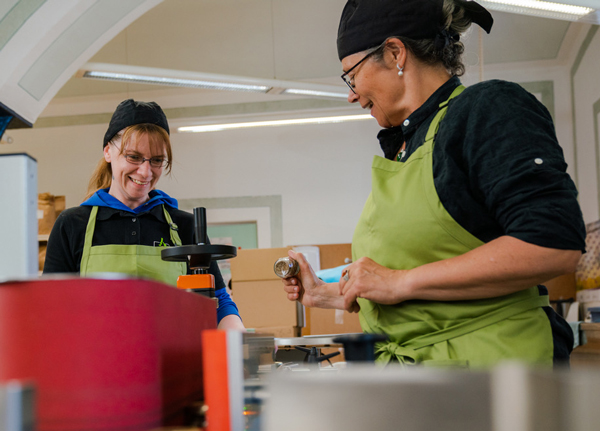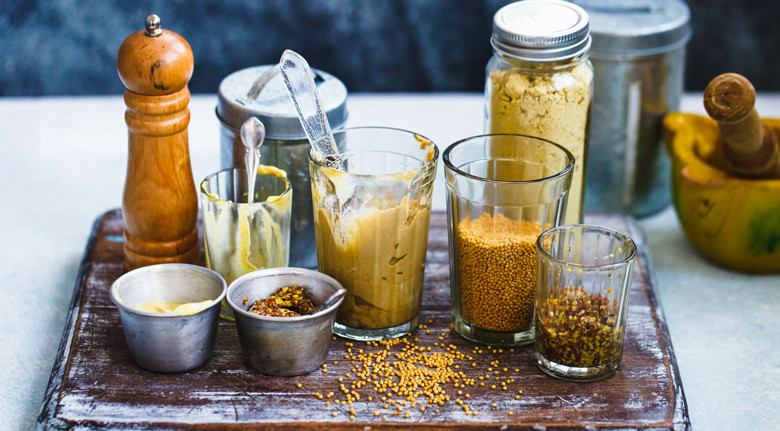About mustard – the popular flavor enhancer with many positive effects
plus great tips for making your own mustard
https://www.bonvinitas.com/media/reviews/photos/thumbnail/780x480c/2d/47/49/about-mustard-the-popular-flavor-enhancer-with-many-positive-effects-68-1752395643.jpgMany Effects
Mustard – the Plant
 A mustard field in Finland. Photo: Finmiki - AdobestockMustard is obtained from the seeds of the mustard plant, which originally comes from warmer regions and whose cultivation has been archaeologically documented in ancient cultures in India. Today, mustard is cultivated agriculturally in many countries around the world, including Germany. The yellow blooming fields resemble early-blooming rapeseed, to which mustard is related, but mustard blooms in mid to late summer. Yellow fields during this time are therefore definitely mustard, not rapeseed. The main variety is white mustard. There is also brown and black mustard, which, however, come from different plants.
A mustard field in Finland. Photo: Finmiki - AdobestockMustard is obtained from the seeds of the mustard plant, which originally comes from warmer regions and whose cultivation has been archaeologically documented in ancient cultures in India. Today, mustard is cultivated agriculturally in many countries around the world, including Germany. The yellow blooming fields resemble early-blooming rapeseed, to which mustard is related, but mustard blooms in mid to late summer. Yellow fields during this time are therefore definitely mustard, not rapeseed. The main variety is white mustard. There is also brown and black mustard, which, however, come from different plants.Preserving the Good Ingredients
Simone Seiboth – a Mustard Ambassador
 Simone Seiboth, the mustard ambassador (right). Photo: Arnulf QuintMustard was already very popular in the Middle Ages, especially among royalty. Archaeologists in Quedlinburg discovered a 1,000-year-old mustard recipe, known as the Ottonians' favorite mustard, which was prepared with horseradish. The ancient recipe is particularly interesting because no sugar was used at the time, and instead, good honey was used as a sweetener. There was also no brandy vinegar back then, as distillation was only introduced 300 years later. Instead, aromatic apple cider vinegar was used to refine the mustard.
Simone Seiboth, the mustard ambassador (right). Photo: Arnulf QuintMustard was already very popular in the Middle Ages, especially among royalty. Archaeologists in Quedlinburg discovered a 1,000-year-old mustard recipe, known as the Ottonians' favorite mustard, which was prepared with horseradish. The ancient recipe is particularly interesting because no sugar was used at the time, and instead, good honey was used as a sweetener. There was also no brandy vinegar back then, as distillation was only introduced 300 years later. Instead, aromatic apple cider vinegar was used to refine the mustard.
For Simone Seiboth, an agricultural engineering graduate also from Quedlinburg, this recipe was a lucky find. Working with archaeologists and historians, she was able to identify the ingredients for a horseradish mustard from that era, which became the origin of her successful mustard production business. In 2009, she also trained as a phytotherapist and in herbal medicine. In her mustard shop, she offers many types of mustard and also provides ingredients for those who want to make mustard themselves, including according to the following recipe – www.Senf-Shop.com
Homemade Herb Mustard: A Simple and Tasty Recipe!
Ingredients 1 – grind
Put everything in a wooden bowl. This mixture needs to be well ground. For best results, add only 1 tbsp of mustard/salt at a time to a mortar. Grind everything finely and transfer the finely ground mixture into the metal bowl mentioned below.
Ingredients 2
Put everything into a metal bowl.
Preparation
Mix the ground flour, the ground salt, beekeeper’s honey, apple cider vinegar, sunflower oil, and water until smooth and lump-free. Pour the finished mustard into clean screw-top jars. Label your mustard jars with name, ingredients, fill date, and best-before date.
After 2 weeks, your Quedlinburg herb mustard is well matured and ready to eat. Stored in a cool, dry place, it will last about 13 months.
Tip: Depending on the season, dried herbs can also be replaced with fresh ones.
Text: Dieter Simon, Publisher and Editor-in-Chief of bonvinitas; Source: Senf-Shop. Photos as indicated





